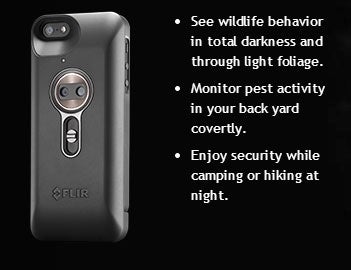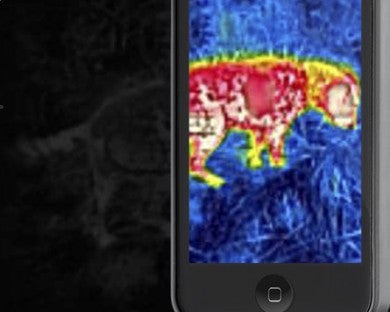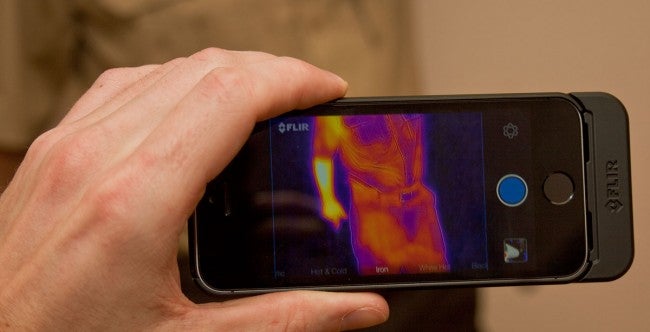FLIR, the largest manufacturer of thermal technologies, and the original inventor of Forward Looking Infra-Red, surprised everyone at CES this year by announcing a compact and affordable thermal imager that fits on an iPhone.
This thermal unit acts as a case for the iPhone, and works with an additional daylight camera to produce the hybrid MSX images that FLIR has patented in their industrial cameras.
The whole thing retails for $350 and has a vague Q1 release date.
The secret to the FLIR ONE’s size is it’s new Lepton core. While previous Tau Core units like the FLIR TS32 or the LS64 were similar size and dimensions to a camera lens, the Lepton is a fraction of that. It’s possibly the smallest and most cost effective thermal core ever invented.
Andy Teich, President and CEO of FLIR told the Wall Street Journal that “Lepton represents our latest, most dramatic step toward our vision of becoming ‘the world’s sixth sense.’ Not only will Lepton support an array of new imaging applications, but its revolutionary price, size, and low power consumption will open new markets for the useful information and data that thermal technology provides.”
 FLIR has been very aggressive in marketing this as a thermal solution for everyone. Some of the suggestions are great, like identifying the drafty spot on your front door. Some are slightly silly: play thermally enhanced hide-and-go-seek?
FLIR has been very aggressive in marketing this as a thermal solution for everyone. Some of the suggestions are great, like identifying the drafty spot on your front door. Some are slightly silly: play thermally enhanced hide-and-go-seek?
I would think TFB readers would have more interest in the wildlife aspect of it, where FLIR encourages you to “see wildlife behavior in total darkness and through light foliage.”
The problem with this statement is that the thermal detector inside the FLIR ONE is very small, 80×60 pixels according to reviewers. (FLIR isn’t promoting the sensor dimensions on their current datasheets)
 The great images we see in the ads are MSX images, built to blend thermal and visible light information with some image enhancing algorithms. But when the lights literally go out, the MSX images lose half of their data. In this case you’re working with the lepton alone, and I am very skeptical of its real range capability.
The great images we see in the ads are MSX images, built to blend thermal and visible light information with some image enhancing algorithms. But when the lights literally go out, the MSX images lose half of their data. In this case you’re working with the lepton alone, and I am very skeptical of its real range capability.
The FLIR Scout PS24 is their entry level outdoor unit, and uses a 240×180 micro-bolometer, which gives it a 350 yard maximum range. That’s the distance necessary for a man sized heat signature to make one pixel on the array go white. You could argue that the more effective range is closer to 100 yards where an untrained user could begin to distinguish shapes and targets.
It’s very hard to say right now what ranges the 80×60 core will provide for low-light and no-light users. Time will tell whether the FLIR ONE and its Lepton core can become a serious opto-electronic solution, or remain firmly planted in the gadget arena.
 Your Privacy Choices
Your Privacy Choices
